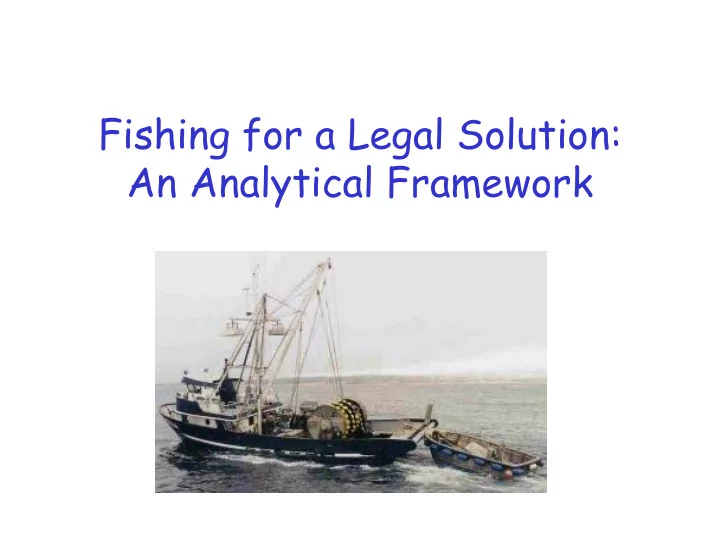

Fishing for a Legal Solution: An Analytical Framework
Clear Objectives Needed for an Effective Legal Solution • Overall Goal: “Minimize gear loss while maximizing recovery.” • Directed Objectives: 1. Prevention --Behavior modification --Economic Incentives for gear disposal --Manufacturing processes 2. Enforcement and Compliance
Clear Objectives --What is being enforced, penalties 3. Coordination, cooperation, and info exchange 4. Outreach/Education 5. Research 6. Remediation (e.g., reporting after loss to possible affected States, clean up) 7. Funding
Analytical Framework Instrument to resolve problem? (General principles v. specific provisions) --UNCLOS (e.g., Arts 192, 194, 197, 200) --MARPOL Annex V and Implementing Guidelines --London Convention
Analytical Framework • “Soft” v. “Hard” Law – Examples of “soft” law include UNGA Resolutions, MARPOL Guidelines and examples of “hard” law include treaties such as UNCLOS, MARPOL, LC – Benefits/Drawbacks (e.g., enforcement, ease of obtaining agreement, resources
Analytical Framework Are these instruments effective? – UNCLOS general principles – MARPOL: disposal into sea of all synthetic ropes and fishing nets prohibited; however, accidental loss exempted from prohibition if reasonable precautions taken. Drawback: garbage recording, management plan applicable only to vessels of 400 gt and above
Analytical Framework --LC: intentional dumping, does not include wastes incidental to normal operations --MARPOL Guidelines: --defines fishing gear (1.7.11) --Exchange of info re marine debris among gov’ts (2.2.4) --Encourage fishing vessel operators and gov’ts to research derelict fishing gear, develop technologies and adopt regs necessary to prevent gear loss, and maximize recovery (3.5)
Analytical Framework -- Ex. of suggested minimization techniques: info exchange b/n fishermen and other ship traffic, gear identification systems, documentation of gear loss, research and technology dev. on gear identification; use of biodegradable materials (3.5 et seq) --Fishermen/seafarers encouraged to retain derelict gear onboard for disposal on land (4.3.5.1) --Notification to appropriate coastal State of location of derelict gear (4.5.4) --Gov’ts encouraged to study provision of reception facilities (6.3.2.2)
Analytical Framework If the problem is not resolved should another instrument be developed or amendments made to an existing instrument? – Difficulties: must be made priority w/n national gov’ts and internat’l institutions, substantial resources needed for creation of a legally binding instrument as well as to ensure compliance once adopted, and inertia must be overcome
Analytical Framework Is there an internat’l institution to address this issue? • RFMOs • FAO, UNEP, IMO --Do any take ownership of issue, are they actively addressing it, and do they coordinate? --Feasibility of taking action within an organization and how to go about it (e.g., rules of procedure, getting issue of the agenda)
Conclusion • Careful consideration must be given to whether regulatory action needed. If so, the objectives for such action must be clear and decisions made regarding at what level action should be taken: nat’l, bilateral, reg’l, global • Priorities should be set with regard to the action to be taken, regulatory and otherwise, in the short, medium, and long term
Conclusion Considerations: 1. Identify a focused group of people to take ownership of the issue and responsibility for action 2. Develop a step by step game plan and strategy and decide on action to be taken, which could include:
Conclusion A. Short Term Action: Info Dissemination ( e.g., target public and consumers, interested and affected parties, and appropriate institutions B. Medium Term Action: Development of a UNGA Resolution, Code of Practice, and/or Action Plan C. Long Term Action: Amendment of MARPOL or development of new instrument
Conclusion
Recommend
More recommend